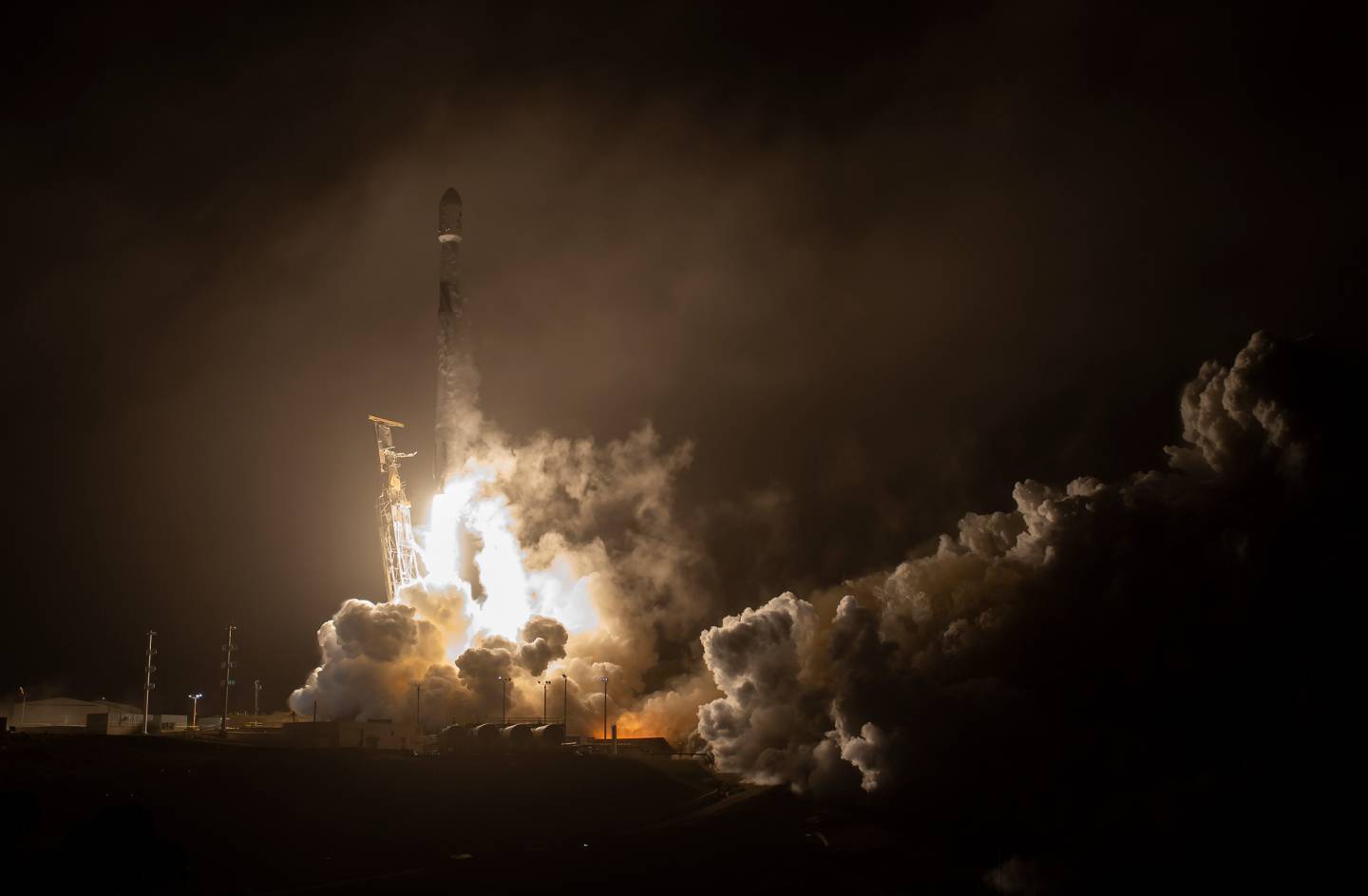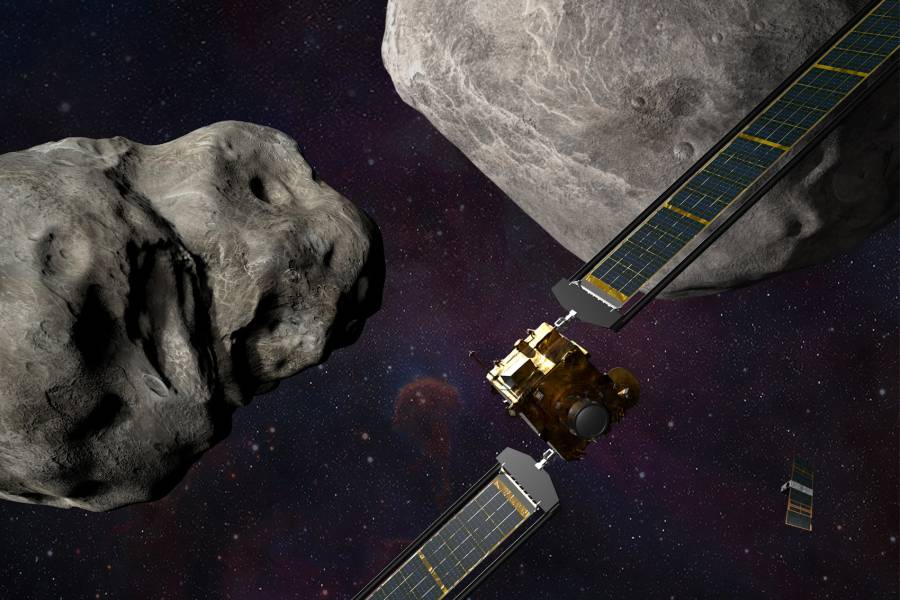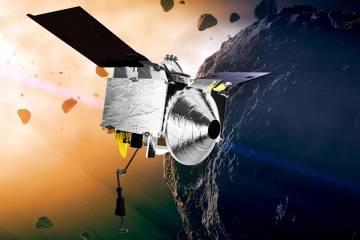- Name
- Michael Buckley
- Michael.Buckley@jhuapl.edu
- Office phone
- 240-228-7536
Lighting up the California coastline early Wednesday morning, a SpaceX Falcon 9 rocket carried NASA's Double Asteroid Redirection Test, or DART, spacecraft into space to begin its one-way trip to crash into an asteroid.
DART—a mission designed, developed, and managed by the Johns Hopkins Applied Physics Laboratory for NASA's Planetary Defense Coordination Office—is the world's first full-scale mission to test technology for defending the planet against potential asteroid or comet hazards. The spacecraft launched Wednesday morning at 1:21 a.m. EST from Space Launch Complex 4 East at Vandenberg Space Force Base in California.
As just one part of NASA's larger planetary defense strategy, DART will send a spacecraft to impact a known asteroid that is not a threat to Earth, to slightly change its motion in a way that can be accurately measured via ground-based telescopic observations. DART will show that a spacecraft can autonomously navigate to a target asteroid and intentionally collide with it. It's a method called kinetic impact, and the test will provide important data to help humankind better prepare for an asteroid that might post an impact hazard to Earth, should one ever be discovered.
"The Double Asteroid Redirection Test represents the best of APL's approach to space science and engineering: identify the challenge, devise an innovative and cost-effective technical solution to address it, and work relentlessly to solve it," APL Director Ralph Semmel said. "We are honored that NASA has entrusted APL with this critical mission, where the fate of the world really could rest on our success."
At 2:17 a.m. EST, DART separated from the second stage of its launch vehicle. Minutes later, mission operators at APL received the first spacecraft telemetry data and started the process of orienting the spacecraft to a safe position for deploying its solar arrays. Almost two hours later, the spacecraft successfully unfurled its two 28-foot-long roll-out solar arrays. They will power both the spacecraft and NASA's Evolutionary Xenon Thruster–Commercial, or NEXT-C, ion engine, one of several technologies being tested on DART for future application on space missions.
"The DART team overcame the technical, logistical, and personal challenges of a global pandemic to deliver this spacecraft to the launch pad, and I'm confident that its next step—actually deflecting an asteroid—will be just as successful," said Mike Ryschkewitsch, head of APL's Space Exploration Sector. "It gives me a lot of assurance that if we ever have to embark on an urgent planetary defense mission, we have the people and the playbook to make it happen."
DART's one-way trip is to the Didymos asteroid system, which comprises a pair of asteroids—one small, the other large—that orbit a common center of gravity. DART's target is the asteroid moonlet Dimorphos, which is approximately 530 feet in diameter and orbits Didymos, which is approximately 2,560 feet in diameter. Since Dimorphos orbits the larger asteroid Didymos at a much slower relative speed than the pair orbits the sun, the slight orbit change resulting from DART's kinetic impact within the binary system can be measured much more easily than a change in the orbit of a single asteroid around the sun.

Image caption: NASA’s Double Asteroid Redirection Test (DART) spacecraft sets off to collide with an asteroid in the world’s first full-scale planetary defense test mission. Riding atop a SpaceX Falcon 9 rocket, DART took off Wednesday, Nov. 24, from Space Launch Complex 4 East at Vandenberg Space Force Base in California.
Image credit: NASA/Bill Ingalls
The spacecraft will intercept the Didymos system in late September of 2022, intentionally slamming into Dimorphos at roughly 4 miles per second so that the spacecraft alters the asteroid's path around Didymos. Scientists estimate the kinetic impact will shorten Dimorphos' orbit by several minutes, and they will precisely measure that change using telescopes on Earth. The results will be used to both validate and improve scientific computer models that are critical to predicting the effectiveness of kinetic impact as a reliable method for asteroid deflection.
"It is an indescribable feeling to see something you've been involved with since the 'words on paper' stage become real and launched into space," said Andy Cheng, one of the DART investigation leads at APL and the individual who came up with the idea of DART. "This is just the end of the first act, and the DART investigation and engineering teams have much work to do over the next year preparing for the main event—DART's kinetic impact on Dimorphos. But tonight we celebrate!"
DART's single instrument, the camera DRACO—short for Didymos Reconnaissance and Asteroid Camera for Optical navigation—will turn on a week from now and provide the first images from the spacecraft. DART will continue to travel just outside of Earth's orbit around the sun for the next 10 months until Didymos and Dimorphos will be a relatively close 6.8 million miles from Earth.
A sophisticated guidance, navigation, and control system, working with algorithms developed at APL called SMART Nav—or Small-body Maneuvering Autonomous Real Time Navigation—will enable the DART spacecraft to identify and distinguish between the two asteroids and then, working in concert with the other GNC elements, direct the spacecraft toward Dimorphos, all within roughly an hour of impact.
Posted in Science+Technology
Tagged applied physics laboratory, double asteroid redirection test










